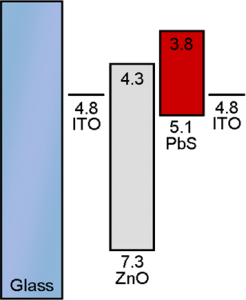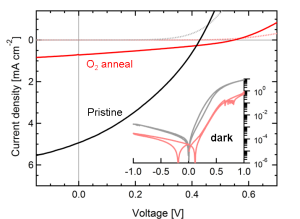Semi-transparent Solar Cells Based on Colloidal Quantum-dot Films

Figure 1: Band diagram of the PbS-ZnO device. The symmetric, transparent ITO electrodes make the device well-suited for stacking in a tandem cell.
Solar cells based on nanocrystalline quantum dots (QDs) offer a promising solution-processable alternative to conventional photovoltaic technologies. In particular, with a bandgap that may be adjusted simply by varying the size of the nanocrystals, QDs are particularly well-suited for incorporation into multijunction device architectures, with stacked layers of QDs absorbing complementary portions of the solar spectrum. The additional ability to modify the surface chemistry and electronic properties of colloidal QDs via ligand exchange and doping gives them a flexibility unmatched in other materials sets.
As a first step towards the realization of multijunction QD photovoltaics, we have developed a solar cell based on a heterojunction between rf-sputtered zinc oxide (ZnO) and solution-deposited lead sulfide (PbS) QDs employing symmetric, transparent indium tin oxide (ITO) electrodes (Figure 1). Our previous work demonstrated the viability of this symmetric-electrode architecture using cadmium selenide (CdSe) QDs [1]; however, the performance of this device was limited by the low mobility of CdSe QDs.

Figure 2: Current-voltage characteristics of the device. The dark current is substantially decreased upon air-annealing, affording an increase in open circuit voltage but a concomitant decrease in photocurrent and efficiency.
PbS possesses both a higher mobility and a better absorbance match with the solar spectrum than CdSe, and other studies have demonstrated the efficiency of the PbS/ZnO interface in rectifying photocurrent flow [2] [3]. Our results have shown that annealing the device in air decreases the dark current and increases the open circuit voltage and fill factor, but at the expense of a decrease in the short circuit current. Given this device’s semi-transparent, symmetric structure, expanding this single-junction device into a stacked multijunction device should be relatively straightforward and will be the focus of our further work.
References
- A. C. Arango, D. C. Oertel, Y. Xu, M. G. Bawendi, and V. Bulović, “Heterojunction photovoltaics using printed colloidal quantum dots as a photosensitive layer,” Nano Letters, vol. 9, pp. 860-863, 2009. [↩]
- J. J. Choi, Y.-F. Lim, M. V. Santiago-Berrios, M. Oh, R.-R. Hyun, L. Sun, A. C. Bartnik, A. Goedhart, G. G. Malliaras, H. D. Abruna, F. W. Wise, T. Hanrath, “PbSe nanocrystal excitonic solar cells,” Nano Letters, vol. 9, pp. 3749-3755, 2009. [↩]
- K. S. Leschkies, T. J. Beatty, M. S. Kang, D. J. Norris, E. S. Aydil, “Solar cells based on junctions between colloidal PbSe nanocrystals and thin ZnO films,” ACS Nano, vol. 3, pp. 3638-3648, 2009 [↩]